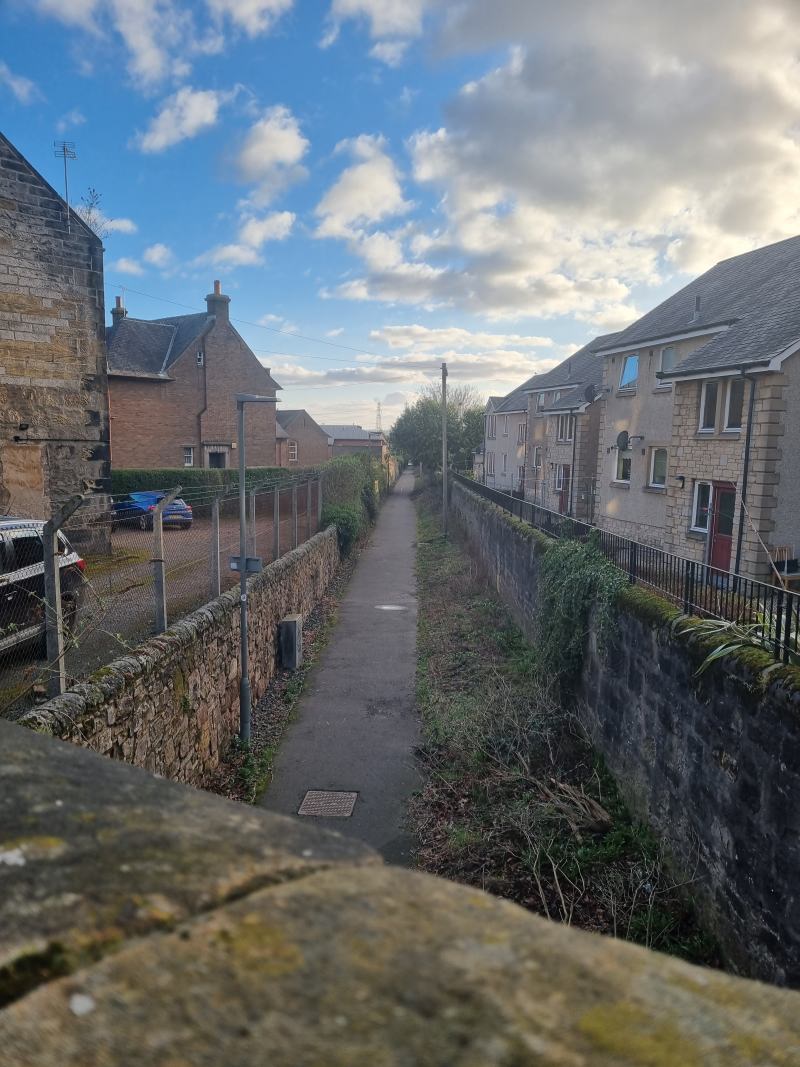The Alloa Waggonway was an early tramway. It was initially two and a half miles long and connected coal mines north of Alloa with Alloa's harbour and industries nearby. The track was wooden, later with an iron running surface, and the wagons were drawn by horses, in similar fashion to canal barges, with bridleways alongside, or used gravity.
The Earls of Mar owned extensive lands around Alloa, and for some centuries coal had been produced from mines on the estate. Edinburgh was the biggest market for coal in the area, and it could easily be carried along the river Forth by boat, but getting the coal to the shore of the river Forth was an issue. John, 7th Earl of Mar first opened the waggonway around 1768 which ran from Alloa Harbour and up through Sauchie, serving the colliery there, to Devon Colliery, north of the hamlet of Fishcross.
The waggonway was a close copy of the Tranent to Cockenzie Waggonway in gauge, wagon size and operating practices. At first it was a single line wooden waggonway; the track gauge was three feet three inches (99 cm) and the wagons were of thirty long hundredweight (1,500 kg) capacity. Soon several branches were added and the system became extensive. There were branches to Collyland mine near Glenochil, built in 1771 and to Sherriffyards Colliery on the eastern shore of Gartmorn Dam. By 1806 the system was extended past the Devon mine near Fishcross, to Tillicoultry.
Clackmannan Waggonway and Kilbagie to Kennetpans Waggonway were later systems by other owners, doing broadly similar work. On the silting up of the harbour at Clackmannan Pow, the Clackmannan waggonway was given a link to Alloa Harbour via the Alloa waggonway.
By 1785 the Alloa waggonway system was worn out and needed to be renewed. This was done on a new plan - "The sleepers are very broad, and only 18 inches from centre to centre. A rail of foreign fir, 4 inches square, is pinned down to them, and another rail, of the same dimensions, is laid over it, and the whole well beat up in good clay; on the top of the upper rail is laid a bar of malleable iron, of 1¾ inches breadth, and nearly six-eighths thick. The waggons have cast iron wheels, 27½ inches diameter, and are supposed to weigh altogether about a ton".
"A waggon carries 30 cwt of coals, and 3 waggons are linked together by chains; so that 1 horse draws 4½ tons of coal at once; and the declivity of the way is so gentle that the same horse draws with ease the 3 empty waggons back to the coal-hill. The advantage of putting the weight into 3 waggons, in place of 1, is very considerable: They are easier to fill and empty; and the throwing the weight over a greater surface, does less damage to the waggon way, and is likewise easier for the horse as it is well known, that almost the only stress a horse has, on a good waggon way, is in the first stating of the waggon; therefore if the whole 4½ tons were put into one waggon, the difficulty would be great; but as the waggons, when standing still, are close to one another, and the chains that link them together are 2 feet long, the horse has only 30cwt. of coals to put in motion; for, when he starts the first waggon, the impetus of it, if it does not actually move, at least greatly assists in moving the second and third".
"The first expense of making this kind of waggon way, is undoubtedly great, being at least 10 shillings per running yard; yet the proprietor has been long ago reimbursed and is a considerable gainer; for although this road has been made these 6 years, it has required no repair worth mentioning, and it is now near as good as when first laid".
Coal mining
Ultimately the waggonway linked the mines to each other and provided connections to the later standard gauge railways in Alloa, the Devon Valley, Tillicoultry as well as the harbour, Devon Iron Works and the Alloa Glassworks. The line was used to gather coal from pits in and near Sauchie for delivery to industry in Alloa and to the harbour for export. In 1879, 159,699 tons were shipped to foreign countries and 15,392 to UK ports.
The Alloa Waggonway lost its importance with the opening of the Tillicoultry Branch of the Stirling & Dunfermline Railway in 1851 but continued for many years until it was finally closed in 1924.
The waggonway today
The former waggonway trackbed has been converted into a cycleway and pedestrian path running from Castle Street, through the earliest railway tunnel in Scotland which passes under Bedford Place, to near Alloa railway station and along the north side of Gartmorn Dam.

Alloa Waggonway former trackbed
Looking south from Drysdale Street - March 2022
